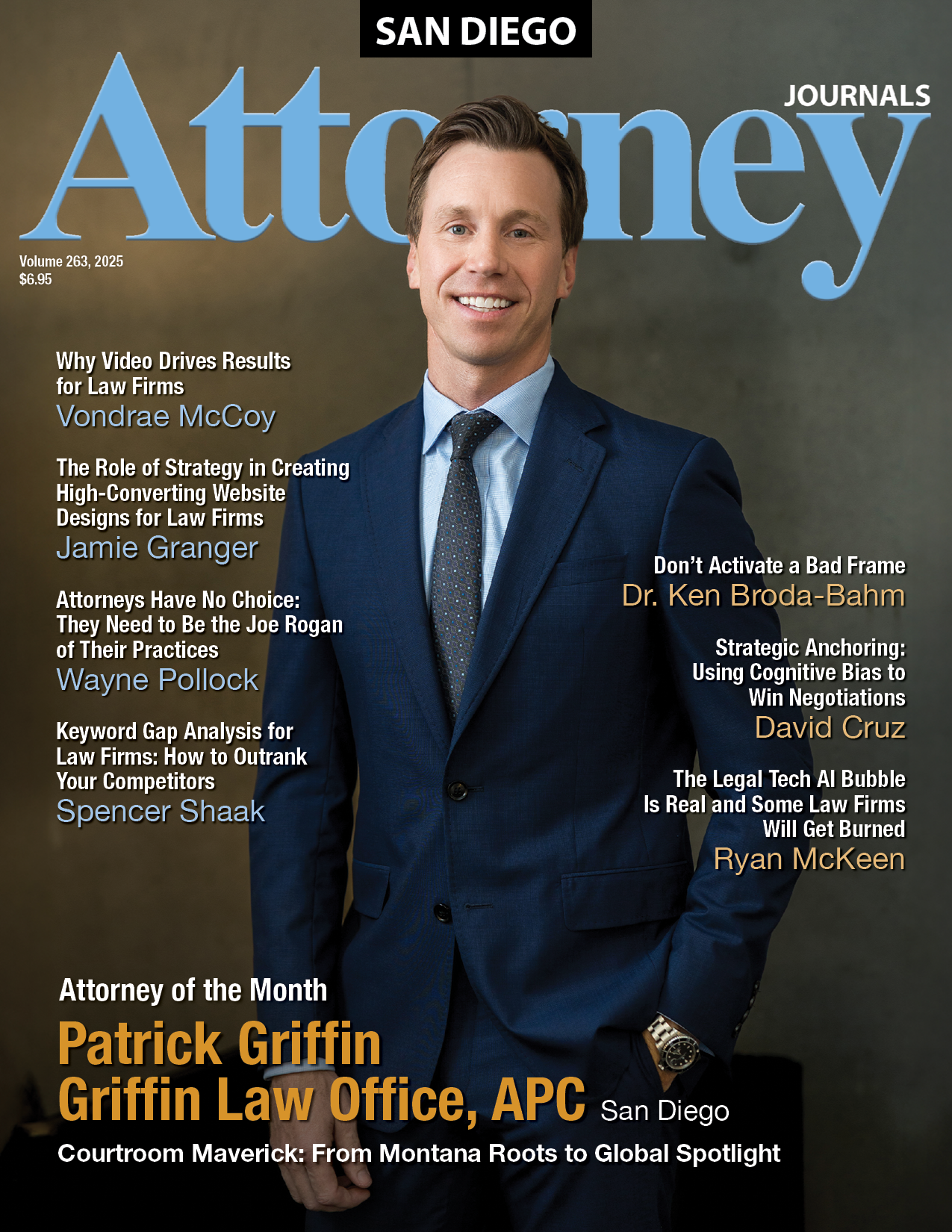Attorney Journals is a Southern California B2B trade publication for and about private practice attorneys. The magazine brings information and news to the legal community as well as providing a platform to spotlight the people, events and happenings of the industry. But that's not all. From marketing advice to business and personal development tips, we're the top resource you need to thrive in the ever-evolving and highly competitive legal industry.
The Latest Stories, Tips and Buzz!
Patrick Griffin, Griffin Law Office, APC
Courtroom Maverick: From Montana Roots to Global Spotlight

CALIFORNIA COURT OF APPEAL Employment CRST Expedited, Inc. v. Super. Ct. (2025) _ Cal.App.5th _, 2025 WL 1874891: The Court of Appeal denied the employer defendant’s petition for writ of mandate seeking to overturn the trial court’s order denying defendant’s motion for judgment on the pleadings in plaintiff’s PAGA action alleging no individual claims, but only claims on behalf of other employees. The issue was whether Labor Code section 2699 authorizes an aggrieved employee to bring a lawsuit that seeks to recover civil penalties imposed for Labor Code violations suffered only by other employees. After plaintiff dismissed his individual claims, because they had been ordered to arbitration, defendant moved for judgment on the pleadings arguing that plaintiff could not bring PAGA claims for violations suffered only by other employees. The Court of Appel denied the writ petition, concluding that a plaintiff may bring a PAGA action seeking the recovery of civil penalties (1) for the Labor Code violations suffered only by the employee, (2) for the Labor Code violations suffered only by other employees, or (3) both. (C.A. 5th, July 7, 2025.) Landlord-Tenant Eshagian v. Cepeda (2025) _ Cal.App.5th _, 2025 WL 1764252: The Court of Appeal transferred this case from the appellate division of the superior court to decide whether a tenant can appeal a judgment for possession in an unlawful detainer proceeding if the landlord has outstanding damages claims that have not been adjudicated. It concluded that a possession-only judgment is not appealable in this situation because it does not resolve all rights of the parties. However, given the uncertainty of the law on appealability at the time defendant filed his appeal, the Court of Appeal treated the appeal as a petition for writ of mandate to avoid any further delay. It concluded that the three-day notice to pay rent or quit served by plaintiff landlord, pursuant to section 1161(2) was invalid for failure to make clear by when and how defendant tenant had to pay the rent, and that defendant would lose possession of the premises if he did not timely cure the default. Plaintiff’s complaint incorporating the three-day notice therefore failed to state a cause of action for unlawful detainer and the Court of Appeal directed the trial court to vacate the judgment in favor of plaintiff and to enter a new judgment in favor of defendant. (C.A. 2nd, June 26, 2025.) Real Property Amundson et al. v. Catello (2025) _ Cal.App.5th _, 2025 WL 1563241: The Court of Appeal reversed the trial court’s interlocutory order identifying the owners of real property as cross-defendant Ruth Catello (Catello) and the estate of decedent Leslie J. Knoles (decedent) and ordering a partition by sale. Decedent had four surviving siblings. Catello and decedent originally acquired title to the real property as joint tenants. About one month before her death, decedent recorded a quitclaim deed that, if valid, severed the joint tenancy and created a tenancy in common with no right of survivorship. Catello and the siblings filed dueling petitions in the probate court. Those proceedings were not yet concluded when the Court of Appeal issued its decision. This appeal arose after Catello filed an action against two of the siblings to cancel the quitclaim deed and for quiet title to the real property, the siblings later filed a cross-claim seeking to partition the real property by sale, and the trial court entered its interlocutory judgment. The Court of Appeal reversed the interlocutory judgment because the siblings did not have standing to bring the partition action. Code of Civil Procedure section 872.210(a)(2) provides that a partition action may be commenced and maintained by an owner of an estate of inheritance in real property. The probate proceedings, however, had not yet determined whether the real property was a part of decedent’s estate. Because the party seeking partition must have clear title, the uncertainty of the outcome of the probate proceedings precluded the siblings from establishing the ownership interest required to bring a partition claim under section 872.210. (C.A. 4th, Decision after rehearing, June 3, 2025.) Torts Mitchell v. Hutchinson (2025) _ Cal.App.5th _, 2025 WL 1904317: The Court of Appeal affirmed the trial court’s order granting defendants Gail B. Hutchinson and the Gail B. Hutchinson Trust’s (defendants) motion for summary judgment in plaintiffs’ action for personal injury and property damage arising from rocks or boulders rolling down a hill and onto the road. Plaintiff sued several defendants who owned adjacent real property. The trial court properly granted summary judgment. Defendants met their initial burden pursuant to Code of Civil Procedure section 437c subdivision (p)(2) of showing that plaintiffs could not prove the element of causation as to both of their causes of action. The burden then shifted to plaintiffs to show the existence of a triable issue of material fact as to (1) whether the rocks came from defendants’ property or, alternatively, (2) whether defendants and the other owners of the adjacent hillside acted negligently in maintaining their slopes such that the burden of proof on the issue of causation would shift to defendants at trial under Summers v. Tice (1948) 33 Cal.2d 80. Because plaintiffs did neither, defendants were entitled to summary judgment. (C.A. 4th, filed June 11, 2025, published July 10, 2025.) n

Employee performance is central to many human resource decisions. When determining compensation changes, incentives, promotions, demotions, reductions-in-force, and while also explaining pay differences, organizations lean on employee performance as the deciding factor. Given its importance, employee performance needs to be carefully documented, managed, and utilized in decision-making. However, recent research suggests many organizations are falling short on performance management. The Society for Human Resource Management (SHRM) and the Society for Industrial Organizational Psychology (SIOP) have performed decades of research related to the effectiveness and validity of performance management processes. A summary of the last five years of selected research is below: Most employees feel that their managers need more training in people management skills, communication, team development, time management, performance management, and leadership skills; and that employee performance is greatly impacted by managers being in leadership roles that they are unqualified for as a leader. Too many organizations are relying on traditional systems of subjective ratings that are done just once or twice per year even though there is extensive evidence that a focus on development and performance discussions throughout the year are much more effective in developing the workforce. SIOP surveys over the past three years have shown that employees see little value in performance management processes that are infrequently done; employees are not inspired by processes that are seen as biased or performed as a checkmark. Growing evidence shows that organizations need to adopt more frequent, real-time feedback and coaching with level-setting/calibration and incentives for seeking and completing current- and next-level development. Current people analytics research done by SHRM shows that traditional performance management processes often get it wrong – and that ratings are more based on relationships in the organization than actual performance; this same research suggests manager bias in performance leads to more high-performing employees leaving the organization. What can organizations do to improve their performance management process? Some recommendations are below: Split the what and the how. a. Have one process based on organizational objectives that measures employee success in completing job duties and tasks (the What) b. Have a second process based on the processes and manners used by that employee to be successful (professionalism, attention to detail, time management, etc.) at completing the objectives (the How). Incorporate talent management into performance management—For employees who have stated they want to seek promotion, also provide ratings on next-level skills and readiness to assist with succession planning. Performance management should be documented year-round and be between more than just the employee and their manager. Comments and feedback should be gathered from anyone at the organization, as well as clients and customers, to create a clearer picture of employee performance. Performance management should include level-setting/calibration meetings where a neutral facilitator helps managers recognize any potential biases they have (such as recency, halo, similar-to-me, leniency, severity, etc.) and adjust their ratings and documentation to ensure consistency in the application of the rating scale. Performance management processes should be based on the results of job analysis, so employees are being rated only on aspects that are valid for their position instead of subjective feelings or feedback. This is a fundamental part of any merit-based performance management system. To effectively evaluate and improve performance based on the merits of what the employee brings to the work, the organization must first understand what the performance domain looks like in terms of essential duties and competencies needed for success. Ultimately, implementing an effective performance management process is more complex than many organizations recognize. And getting it right is critical to ensure the process is an effective management tool. With the current focus on making merit-based decisions, performance management should be tied to specific job requirements. To advance a skills-based hiring process, the process should also be focused on learning and development, rather than simply completing a requirement. For a performance management process to be successful, it requires organizational commitment from all levels to spend the time necessary to yield actionable information for employees.

There is a well-known principle in communication circles, first expressed by cognitive scientist George Lakoff: “When we negate a frame, we evoke the frame.” It means that even when we try to deny a specific attack against us, when we use the same terms, we end up giving space and power to that attack. The idea, expressed in Lakoff’s book, Don’t Think of an Elephant, is built on the demonstrated tendency for our unconscious mind to grasp onto an offered association even when that association is being rejected. The classic example is former President Richard Nixon’s statement that, “I am not a crook.” He can deny it, but now we’re still thinking of him in the same category as “crook.” In a more recent example, conservative activist Mike Lindell was being deposed in a defamation lawsuit, and completely lost his cool after the attorney cast aspersions on his “My Pillow” product, shouting, “They’re not lumpy pillows!” That case had nothing to do with pillow quality, but in litigation, there is often an actual need to deny whatever bad thing the other side is projecting against you. Your credibility might depend on rejecting the negative frame the other side is trying to place around you. You want to convey that you’re not “greedy,” “careless,” or “dishonest,” but you also want to do so without sounding defensive and without further activating the same associations you’re trying to negate. In this post, I’ll share some practical ways to do that. Don’t Activate Bad Frames, Reframe Instead The advice from Lakoff is to avoid using the other side’s negative terms: “Avoid repeating the charges! Instead, use your own words and values to reframe the conversation. When journalists protest that they are ‘Not the Enemy,’ they should remember how well ‘I am not a crook’ worked for Nixon.” The better course is replacing the other side’s bad frame with your better frame. Journalists should emphasize that they’re on the side of truth. Nixon could have emphasized that he followed the law (if that were the truth). In creating your messages for discovery and trial, the same principle applies. State it in the positive: Don’t say “it isn’t about greed,” but do say “it is about justice and being made whole.” Don’t say “We weren’t careless,” but do say, “We took every reasonable precaution.” Don’t say, “He wasn’t dishonest,” but do say, “He told the truth.” There are two specific settings where it is important to avoid the negative frame. In Jury Selection Jury selection is different than the other messaging stages of trial because you are trying to find and excuse those jurors who would be less fair to your clients. You can’t afford to fully avoid the negative frames because you are trying to determine who holds onto those frames. Still, it is important to conduct a targeted examination in order to expose the less favorable jurors without giving undue emphasis to these negative frames. A voir dire approach I’ve demonstrated, the Pivot, for example is based on using strategically-phrased hand-raising questions (Who believes…) to identify a minority of jurors with less favorable attitudes and experiences, while reserving your open-ended follow up questions (Why? Tell me more about that…) for those in a majority on the more favorable side of the frame that is helpful to your side. In Testimony During examination in deposition or trial, witnesses can face a strong impulse to deny a negative conclusion or association they’re being handed by counsel for the other side. And sometimes, of course, that impulse to negate is important. To avoid looking evasive, it is necessary to answer directly, but to avoid activating the other side’s framing, it is important to use your own words. example, counsel for the other party might ask a doctor defendant, “So, you skipped that particular diagnostic test, correct?” Instead of a defensive, “No, I did not ‘skip’ it…” it is better to respond, “No, I followed the protocol, which includes other steps rather than this test. “ More broadly, attention to language and to framing at all pretrial and trial stages, including openings and closings, is important. The task is not just the logical one of deciding what frames to promote and reject, but also the psychological steps in taking care with what is being evoked and reinforced.

Is your firm unknowingly surrendering potential clients to its competitors? Prospects are online everyday researching the legal services they need, but if your pages aren’t appearing for the keywords they query, they’re going to head elsewhere. As a law firm in an increasingly competitive digital space, this isn’t just a problem—it’s a huge missed opportunity that’s costing your firm revenue. It’s also entirely reversible. By taking the time to conduct a keyword gap analysis, you can identify the search terms your competitors rank for, but you don’t. Tap into those keywords, and you can start to outrank your rivals and begin attracting more high-value prospects to your site. I’ve seen firsthand how the information gleaned from a well-thought-out keyword gap analysis can help law firms cut through the digital noise in a crowded online marketplace. If you’re ready to take your SEO strategy to the next level, let’s dive in! Understanding Keyword Research Keywords serve as the bridge between what potential clients search for and the legal services you provide. Effective keyword research goes beyond simply identifying highly searched terms. It requires understanding search intent—the “why” behind every query. When someone searches for “personal injury lawyer,” they have different needs than someone searching for “how to file a personal injury claim.” The first indicates they’re ready to hire legal representation, while the second suggests they’re still in the information-gathering phase. For law firms, this distinction matters tremendously. High-conversion keywords typically include location-specific terms like “divorce attorney in Chicago” or service-specific phrases such as “wrongful termination lawyer.” These targeted searches often represent prospects who are further along in their decision-making process. Long-tail keywords deserve special attention in legal marketing. While “lawyer” might generate massive search volume, “affordable immigration lawyer for green card applications” targets a specific audience with clear intent. These longer, more specific phrases typically face less competition and attract more qualified prospects. In addition, Google’s AI Mode and LLMs are shifting user behavior toward more conversational searches, which often take the form of long-tail queries and detailed questions. What Makes Keyword Gap Analysis Essential In my experience, most legal practices face intense competition online, with established firms dominating many valuable search terms. Keyword gap analysis helps level the playing field by revealing overlooked opportunities and emerging trends in legal searches. Consider this scenario: Your personal injury firm ranks well for “car accident lawyer,” but your competitor consistently appears for “rideshare accident attorney” and “bicycle accident lawyer”—terms you never considered targeting. A keyword gap analysis would identify these opportunities, allowing you to create relevant content and capture leads among potential clients querying those terms. The benefits extend beyond just finding new high-intent search terms. Keyword gap analysis provides insights into your competitors’ content strategies, reveals seasonal trends in legal searches, and helps you understand which topics resonate with your target audience. Regular gap analysis also keeps you ahead of industry changes. As new legal issues emerge or regulations change, search patterns evolve. Firms that monitor these shifts through competitor analysis can quickly adapt their content strategies to capture emerging opportunities. Performing a Keyword Gap Analysis So, what does it take to conduct a thorough keyword gap analysis? Identify Your True Competitors An effective analysis begins with identifying the right competitors to analyze. Focus on law firms that serve similar clients in your focal practice areas. Also review firms operating in your geographic area to assess how they perform locally—for example, through their office location pages and Google Business Profiles. Don’t just consider the biggest firms in your market—sometimes smaller, specialized practices can reveal valuable niche opportunities. Start by searching for your primary practice area keywords in Google. The firms consistently appearing in the top 10 results should be on your analysis list. Pay attention to both organic results and Google Ads, as firms investing in paid search often have sophisticated keyword strategies worth tracking and evaluating. Consider both direct and indirect competitors. A direct competitor might be another family law firm in your city, while an indirect competitor could be a legal information website that ranks for questions your potential clients ask. Identify Potential Competitor Keywords Once you’ve selected competitors, use your chosen analysis tool—Semrush Keyword Gap, Content Gap by Ahrefs, SimilarWeb, etc.—to extract their keyword data. Focus on terms that align with your practice areas and geographic market. A personal injury firm in Texas that only serves clients within the state shouldn’t prioritize keywords specific to New York workers’ compensation law. Look for patterns in your competitors’ keyword strategies. Are they targeting specific types of cases within your practice area that you haven’t considered? Do they rank for informational keywords that could drive top-of-funnel traffic to your firm? Pay special attention to local SEO opportunities. Competitors might rank for neighborhood-specific terms, nearby city names, or location-based legal questions that you could also target. And don’t overlook long-tail variations of your core keywords. Your competitor might rank for “how to choose a divorce lawyer” while you only target “divorce lawyer.” These informational keywords can attract prospects early in their research process. Choose Competitor Keywords to Target Not every keyword your competitors rank for deserves your attention. Prioritize opportunities based on relevance, search volume, competition level, and your firm’s capacity to create quality content. Relevance should be your first filter. A keyword might generate significant traffic for a competitor, but if it doesn’t align with your services or target clients, it won’t benefit your firm. Focus on keywords that match your practice areas and can realistically convert into qualified leads. Evaluate the competitive landscape for each keyword. Tools like Ahrefs and Semrush provide keyword difficulty scores that estimate how challenging it would be to rank for specific terms. As a general rule, newer websites should target keywords with lower difficulty scores, while established firms with strong domain authority can pursue more competitive terms. Consider search intent carefully. Keywords indicating immediate need for legal services (like “hire DUI lawyer”) typically offer higher conversion potential than informational searches (like “what happens at a DUI hearing”). Balance your strategy between capturing immediate demand and building long-term organic growth through educational content. Creating Content Around High-Intent Keywords Discovering keyword opportunities is only the beginning. Success requires creating compelling, authoritative content that addresses the search intent behind each target keyword. For legal content, quality and expertise matter more than quantity. Google’s algorithms increasingly favor content that demonstrates expertise, authoritativeness, and trustworthiness—particularly important for YMYL (Your Money or Your Life) topics like legal services. When creating content for legal keywords, consider the specific needs of searchers. Someone searching for “child custody modification lawyer” likely needs immediate legal assistance, making a well-optimized service page more appropriate than a general blog post. Conversely, “child custody laws in [state]” suggests an informational need better served by comprehensive educational content. Structure your content to address common questions and concerns related to each keyword. Use clear headings, bullet points, and concise paragraphs to make information easily digestible. Include relevant case studies, testimonials, or examples when appropriate, while maintaining client confidentiality. Don’t forget technical SEO elements. Optimize title tags, meta descriptions, and header tags to include your target keywords naturally. Ensure your content loads quickly and provides an excellent user experience across all devices. Measuring Success and Continuous Improvement Keyword gap analysis isn’t a one-time activity. Legal markets evolve, competitors adjust their strategies, and new opportunities emerge regularly. Establish a routine for monitoring your progress and identifying new gaps. Track key metrics including organic traffic growth, keyword ranking improvements, and most importantly, lead generation from organic search. Use tools like Google Analytics and Google Search Console to monitor how your targeted keywords perform over time. Set realistic expectations for results. SEO typically requires several months to show significant impact, particularly in competitive legal markets. Focus on gradual improvements, rather than expecting immediate dramatic changes. Keep monitoring your competitors’ activities. They may be conducting their own gap analysis and identifying opportunities you’ve overlooked. Keeping an eye on the competition helps you stay ahead of trends and maintain your search visibility. Takeaway The digital landscape is always evolving. But by prioritizing a data-driven keyword strategy that prioritizes search intent, your firm can achieve the online visibility critical to achieving its business development goals.

In negotiation, the first number often carries disproportionate weight. While perhaps not always an absolute guarantee of victory, the concept of “anchoring bias” suggests it’s a powerful and frequently underestimated advantage. Anchoring, in essence, describes our well-documented human tendency to rely too heavily on the first piece of information offered (the “anchor”) when making subsequent decisions. The human brain, in its quest for efficiency, often latches onto that initial number and adjusts insufficiently from it. The brain’s adjustment occurs even when the anchor is arbitrary or irrelevant. This initial figure frequently frames the perceived zone of possible agreement, profoundly influencing the counter-offers and concessions that follow. The legal field, a constant arena of negotiation, is no stranger to the potent effects of anchoring. In legal negotiations, a delayed response can be more than embarrassing; it can be a costly missed opportunity. Being proactive in establishing an anchor is key to avoiding that frustration, as the initial offer often acts as a potent psychological anchor, shaping how individuals perceive and process information throughout the negotiation. Consider a common scenario in business litigation: the initial settlement demand or offer. Imagine a plaintiff’s attorney, after thorough case evaluation, believes a fair settlement value is around $500,000. However, understanding anchoring, they might strategically open negotiations with a demand of $950,000. Conversely, a defense attorney, also aiming for a $500,000 resolution, might counter-intuitively open with an offer of $150,000. While these initial figures may seem far from the eventual target, they serve a crucial psychological purpose. The $950,000 demand, even if perceived as high, immediately frames the negotiation in a higher range. The first offer tends to establish a baseline, and all subsequent offers are evaluated in relation to this initial benchmark. Even if the recipient believes the initial offer is unreasonable or “out of line,” it still exerts a gravitational pull on the negotiation. Subsequent discussions, even if they bring the number down significantly, are often subconsciously tethered to this initial anchor. It becomes psychologically more challenging for the opposing side to dramatically pull the number below a certain threshold once that high anchor is set. Similarly, the lowball offer from the defense aims to drag the perceived acceptable range downwards. The negotiation then becomes a process of adjusting from these starting points. Research consistently shows that these adjustments are often insufficient, pulling the final agreed-upon number closer to the initial anchor than it might have been otherwise. This illustrates how a well-placed initial figure can powerfully shape the entire negotiation landscape, often dictating the perceived zone of possible agreement before substantive arguments are even fully exchanged. The party making the first offer often benefits from demonstrating a compelling analysis of the case’s strengths and weaknesses, and their preparedness to articulate the reasoning behind their offer can lend additional credibility to the anchor. Nuances in Crafting Your Anchor: Precision and Range The power of the first offer isn’t just about being first; it’s also about how that number is presented. Studies have shown that precise numerical first offers (e.g., $947,500 instead of $950,000) tend to be more effective anchors than rounder numbers. A precise number can signal that the offeror has carefully considered the value and is less likely to move significantly from their position. However, an overly aggressive first offer can risk derailing the negotiation if it causes the other side to question your credibility or the feasibility of an agreement. A more sophisticated approach involves “range offers”. Research from Columbia University has highlighted “bolstering ranges” as particularly potent. [i] For example, a seller asking $7,000–$7,500 for a car instead of a flat $7,000. This type of offer aggressively stretches the bounds of a single-figure offer while also conveying flexibility and accommodation. Buyers receiving such offers tend to make greater concessions, partly because the range suggests a more ambitious bottom line for the offeror and can appear more polite than a single aggressive figure. This allows the offeror to claim more value while potentially mitigating reputational damage from a very aggressive single-point offer. Generally, ranges of about 5% to 20% of the base figure appear to work best. A well-crafted first offer, therefore, subtly communicates strategic thinking, understanding of the issues, and negotiation style. This isn’t just some abstract theory; I’ve experienced this firsthand in my own career, especially while handling large, multi-million-dollar settlements for large insurance companies. In those high-stakes legal negotiations, you quickly learn how critical anchoring is. If you don’t put that first number on the table, you can bet the other side will. And once their number is out there, it’s like that’s the new center of gravity for the whole discussion. Trying to pull the negotiation significantly away from their initial figure? Even with compelling arguments or strong evidence, overcoming that initial number is an uphill battle. Research shows all subsequent judgments are made by adjusting away from that initial anchor. That first anchor really does set the entire playing field. Fortunately, in those situations, I always made it a point to try and build positive, professional relationships with the opposing counsel. I found that this focus on a good working relationship, combined with a solid understanding of how anchoring works, really helped close deals that felt fair and beneficial to everyone involved. It’s so important to remember that anchoring isn’t about trying to bully or coerce anyone; it’s much more about strategically framing the conversation from the outset. Honestly, when both sides have a sense of these psychological dynamics, you’d be surprised how often you can find collaborative solutions. So, why does anchoring have such a strong pull on us? It comes down to a few interesting ways our brains are wired. First, there’s something called the “insufficient adjustment” phenomenon. This basically means that even if we suspect an initial number might be off, we tend not to adjust our estimates far enough away from it. It’s like that first number has a magnetic pull. Second, that anchor triggers what psychologists call “selective accessibility”. This is a fancy way of saying that once an anchor is set, our brains start actively looking for information that confirms it, while often unintentionally downplaying anything that contradicts it. So, if a high number is thrown out there, we subconsciously search for reasons to justify it. And lastly, especially when we’re facing uncertain or complex situations (which negotiations often are!), an anchor gives us a sense of cognitive ease. Anchors provide a starting point, a mental shortcut that simplifies the tough job of figuring out what something is worth or what a fair outcome looks like.

Walk the halls of any legal tech conference today and you’ll trip over dozens of AI startups promising to revolutionize law practice. Each booth features the same pitch: “We’re ChatGPT, but for lawyers!” The valuations are astronomical. The demos are slick. The value proposition? That’s where things get murky. The legal tech world has become a gold rush, and most prospectors are selling fool’s gold. Every week brings announcements of new AI tools that are nothing more than thin wrappers around OpenAI, Claude, or Google’s models. These companies take a general-purpose language model, add a legal-sounding name, maybe some prompt engineering, and suddenly they’re worth millions. Or in Harvey AI’s case, $5 billion. Let that sink in. Harvey AI, which essentially provides access to large language models with some legal flavoring, commands a valuation that exceeds the GDP of some small nations. For what? Features that a $20 monthly Claude subscription or Google Workspace already provides? The proliferation is staggering. Legal AI tools are multiplying like rabbits. Contract review AI. Research AI. Brief writing AI. Deposition prep AI. Due diligence AI. Each claiming to be purpose-built for legal work, each demanding premium pricing, each essentially doing what you could accomplish with direct access to the underlying models. This isn’t innovation. It’s arbitrage. These companies position themselves between law firms and the actual AI providers, adding minimal value while extracting maximum fees. They’re middlemen in expensive suits, and law firms are falling for it. The problem runs deeper than overvaluation. Law firms signing multi-year contracts with these vendors are possibly making a critical strategic error. They’re betting on intermediaries in a rapidly evolving market where the underlying technology improves monthly. Today’s cutting-edge legal AI wrapper becomes tomorrow’s obsolete interface. Meanwhile, firms are locked into contracts, paying premium prices for increasingly outdated access to technology they could use directly. Why This House of Cards Will Collapse The legal AI bubble mirrors every tech bubble before it. Massive valuations built on thin value propositions. Investors pouring money into companies whose entire business model depends on other companies’ technology. Law firms, traditionally conservative with technology adoption, suddenly throwing caution to the wind because everyone else is doing it. The fundamental question every firm should ask: What unique value does this legal AI vendor provide that I cannot get from direct access to Claude, GPT-4, or Gemini? Strip away the marketing speak and legal jargon. Look at the actual functionality. In most cases, you’re paying a massive premium for prompt engineering you could do yourself. Consider document review. Multiple legal AI companies offer document review solutions powered by large language models. Their secret sauce? Prompts that tell the AI to focus on legal concepts. Any competent lawyer with an afternoon to spare could create similar prompts. Yet firms pay thousands per month for this “specialized” access. Research platforms fare no better. They ingest legal databases and wrap them with AI interfaces. The AI doesn’t understand law any better than the base model. It’s just been prompted to format responses like legal memoranda. Again, something any associate could configure with basic prompt engineering skills. The Better Path Forward Smart firms should reject the vendor gold rush and build internal AI competency instead. This doesn’t mean avoiding AI. It means being strategic about implementation and skeptical about vendors selling repackaged access to technology you can use directly. Start with direct subscriptions to major AI platforms. Google Workspace with Gemini costs a fraction of specialized legal AI tools. Claude Pro provides powerful language processing for less than most lawyers bill in an hour. Google’s Notebook LM is a favorite of mine. These platforms improve constantly, and you benefit immediately from upgrades without renegotiating vendor contracts. More critically, invest in people, not platforms. Hire or develop internal futurists and explorers. These team members should understand both legal practice and AI capabilities. Their job isn’t to build AI from scratch but to identify opportunities, test solutions, and separate genuine innovation from expensive vaporware. Create an AI evaluation framework. Before signing with any legal AI vendor, your internal team should prototype similar functionality using direct AI access. If they can replicate 80% of the vendor’s offering in a week, you’re looking at overpriced middleware, not essential technology. Establish small pilot programs. Test AI applications on real work with controlled scope. Learn what works, what doesn’t, and what your firm actually needs. This hands-on experience becomes invaluable when vendors pitch their solutions. You’ll spot the fluff immediately. Build prompt libraries and workflows internally. The “secret sauce” of most legal AI tools amounts to well-crafted prompts and integrated workflows. Your team can create these without paying vendor premiums. More importantly, you’ll own and control these assets, adapting them as needs change. The Reckoning Approaches The legal AI bubble will burst. Not because AI lacks value in legal practice, but because the current vendor ecosystem is unsustainable. When firms realize they’re paying Harvey AI prices for Google Gemini functionality, the correction will be swift and brutal. Firms committed to long-term vendor contracts will find themselves trapped, paying premium prices for increasingly commoditized services. Those who invested in internal capabilities will adapt seamlessly, switching between AI providers as technology evolves. The winners in legal AI won’t be the firms with the biggest vendor contracts. They’ll be the ones who understood early that AI is a tool, not a solution. Who recognized that sustainable advantage comes from how you use technology, not which middleman you pay to access it. Stop signing contracts with AI vendors promising to transform your practice. Start building the internal capacity to transform it yourself. The bubble is real, the burst is coming, and your firm’s future depends on being on the right side when it happens. The legal profession stands at an inflection point. We can chase shiny vendors and astronomical valuations, or we can do what lawyers do best: think critically, evaluate evidence, and make reasoned decisions. The choice seems obvious. The question is whether firms will make it before their competitors do.











